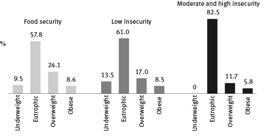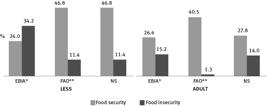Abstract
Aim:To evaluate and compare household food security situations in the rural area of a Brazilian city by three different methods: Availability of food energy at home, nutritional status and Perception of food insecurity. Methods: Cross-sectional study of 79 families living in 19 rural communities in a small city in Minas Gerais, Brazil, including a total of 272 residents. Families were selected by drawing lots, respecting the proportionality of families per community. The inclusion criteria included living in rural areas, inhabiting a selected household, and using food products available for consumption, by purchase and production. During family visits, nutritional status was analyzed by anthropometry, the perception of food insecurity by Food Insecurity Scale (EBIA) and availability of food energy at household for 30 days. Results: Of the 79 families of family farmers, 12.7% were considered to be unsafe for availability of food energy at household, 24.0% due to the presence of low weight at the household and 49.5% by EBIA. There was a low correlation among the methods, with differences between them (Kendall W 0.162 p <0.001). Food insecurity was associated to the presence of at least one individual aged less than 18 years old in the household. Food security classified according to EBIA was associated with an increase in the number of people living in the household, the production of vegetables and fruits. Conclusions: No single indicator can cover several dimensions of food security. Food Security involves a broad and multifaceted approach; therefore, its thorough evaluation requires different classification methods.
Key words
Food security; Food availability; Family farming; Anthropometry; Perception of food insecurity

 Thumbnail
Thumbnail
 Thumbnail
Thumbnail
 Source: Thesis DUTRA, L.V. Food and nutrition insecurity and self-sustainable production in rural area of São Miguel do Anta, Minas Gerais.
Source: Thesis DUTRA, L.V. Food and nutrition insecurity and self-sustainable production in rural area of São Miguel do Anta, Minas Gerais.
 Source: Thesis DUTRA, L.V. Food and nutrition insecurity and self-sustainable production in rural area of São Miguel do Anta, Minas Gerais. Note:*chi-square, p<0.05. **Fisher, p<0.05.
Source: Thesis DUTRA, L.V. Food and nutrition insecurity and self-sustainable production in rural area of São Miguel do Anta, Minas Gerais. Note:*chi-square, p<0.05. **Fisher, p<0.05.